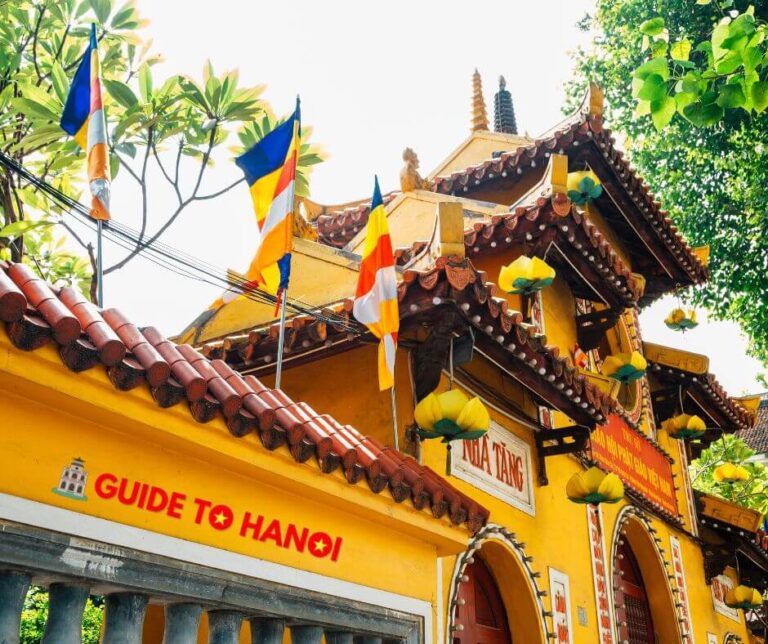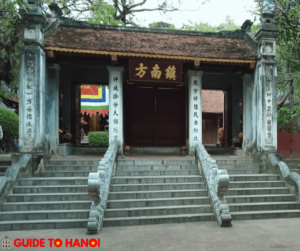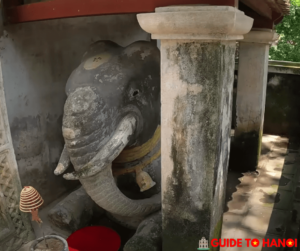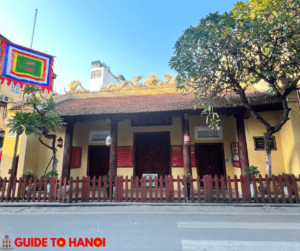Quan Su Pagoda (Ambassador’s Pagoda)
Nestled at 73 Quan Su Street, Quan Su Pagoda in Hanoi is not just a temple; it’s a living testament to centuries of history and spirituality.
Let’s embark on a journey through time and tales!
Origins Unveiled: From Thatched Hamlet to Spiritual Oasis
Dating back to the 15th century, Quan Su Pagoda’s roots trace to An Tap hamlet, where villagers prayed for peace in humble thatched houses.
Fast forward, and the pagoda stands strong, embracing the echoes of bygone eras.
Royal Welcome and Temple Tales
During the reign of King Le The Tong, Quan Su became the royal welcome hub for envoys from Champa and Ai Lao.
These devout Buddhists left an indelible mark, building a temple within Quan Su’s grounds.
Time may have faded the king’s building, but the pagoda endures.
Monk’s Renovation: Bells, Statues, and Spiritual Splendor
In the 19th century, Monk Thanh Phuong transformed the pagoda, adding corridors, painting statues, and casting bells.
The front hall reveres Buddha, while the back hall pays homage to the national monk Minh Khong. Quan Su’s spiritual evolution continued.
Headquarters of Tranquility: Tonkin Buddhist Association
In 1934, Quan Su Pagoda became the focal point for the Tonkin Buddhist Association.
Fast forward to 1942, when architects Nguyen Ngoc Ngoan and Nguyen Xuan Tung gave the pagoda a facelift, approved by Vinh Nghiem Patriarch himself.
The result? A tranquil haven in the heart of Hanoi.
Architectural Charm: Beyond Gates and Courtyards
Explore Quan Su’s architectural wonders!
The three-story gate, the bell tower, and the solemnly adorned Buddha hall – every step unveils a masterpiece.
The pagoda’s grandeur is a visual delight from the Amitabha Buddha to the Cuu Long court.
Rare Temples and Indigenous Beliefs
Discover the Patriarch’s church on the Dai Hung Bao Dien side, a rare gem in northern Vietnam.
Quan Su Pagoda preserves Dharma but steers clear of worshiping the “mother of the three-four palaces,” showcasing a unique blend of Buddhism and indigenous beliefs.
Beyond Temples: Monastic Life and Learning
Quan Su Pagoda isn’t just a place of worship; it’s a hub of knowledge—rows of buildings house libraries, lecture halls, guest houses, and monk rooms.
Dive into the world of Buddhism beyond the temples’ serene facade.
A Beacon of Unity: Witness to Buddhist History
For over half a century, Quan Su Pagoda has witnessed the ebb and flow of Vietnamese Buddhism.
From unifying domestic Buddhist organizations to global integration, it stands as a beacon of unity.
On May 13, 1951, the world Buddhist flag graced the skies of Hanoi, marking a historic moment.
Embrace the Spiritual Tapestry!
Ready to unravel the spiritual tapestry of Hanoi? Quan Su Pagoda awaits, inviting you to explore centuries of history and tranquility.
Embark on a journey that transcends time – discover the heart of Vietnamese Buddhism.
Plan your visit now, and let the echoes of centuries guide your steps!

Quan Su Pagoda: Quick Facts
| Location | 73 Quan Su Street, Hoan Kiem District, Hanoi City |
|---|---|
| Origins | 15th century, An Tap hamlet, Co Vu ward |
| Architectural Highlights | Three-story gate, bell tower, Buddha hall, Cuu Long court |
| Renovations | Monk Thanh Phuong’s enhancements in the 19th century |
| Historical Significance | Tonkin Buddhist Association headquarters since 1934 |
| Unique Features | Rare Patriarch’s church, Preservation of Dharma |
| Academic Hub | Central Higher School of Buddhist Studies since 1981 |
Address:
- 73 P. Quán Sứ, Trần Hưng Đạo, Hoàn Kiếm
Opening Hours:
- 7:30–11:30, 13:30–17:30
Entrance Fee:
- 10,000 VND




